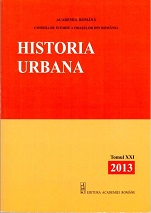Influenţa privilegiilor comerciale asupra evoluţiei spaţiului urban din oraşele săseşti ale Transilvaniei (secolele XIV–XV)
The Role of Trade Privileges in the Evolution of the Urban Space of the Saxon Towns in Transylvania (14th–15th Centuries)
Author(s): Maria Crîngaci ȚiplicSubject(s): History
Published by: Editura Academiei Române
Keywords: medieval towns; trade privileges; urban space; Transylvania; Saxons;
Summary/Abstract: In this study, we intend to examine the Saxon towns in the Seven Chairs (the Province of Sibiu) of Transylvania, with special reference to Sibiu, Sebeş, and Sighişoara. The time of the Angevins and that of Sigismund of Luxembourg played a decisive role in Hungary’s economic development, and, in particular, in the spread of urban settlements. Many settlements in Transylvania were attested as towns during the reign of the Angevins: Sibiu (first attestation as civitas in [1324]), Vinţu de Jos (1309), Cluj (1316), Cisnădie (1323), Orăştie (1324), Baia de Arieş (1325), Sebeş (1341), Braşov (1344), Cricău and Ighiu (1347), Bistriţa (1349), Mediaş (1359), Aţel (1365), Sighişoara (1367), Aiud (1378). King Louis I was well known to have been most generous in granting privileges to cities. For example, unlike other Transylvanian towns, Sibiu enjoyed the largest number of trade privileges. Sibiu, along with the Seven Chairs, played an overwhelming role in the long-distance trade with Central Europe via the Kingdom of Hungary. During the period when the trade privileges were granted, there was an unexpected growth of the urban space in the city of Sibiu. This growth was marked by the emergence of new architectural programs (which caused the alteration of the fronts and of the façades delimiting the commercial space) and by the building of very strong fortifications. From the very succinct information presented in this study, it can be ascertained that, in the case of Sebeş, Sighişoara, and Sibiu, trade privileges have exerted a major influence on the area designed for commercial activity, on the evolution of the urban space and its well defined demarcation by the enclosures. We can even speak about an urban strategy, if we take into account that the urban structure, in particular that of Sebeş, along with that of Sibiu and of Sighişoara, which complied with the typology of planned settlements. We believe that the urban strategy initiated in the 13th century continued also throughout the 14th and the 15th centuries, yet on a lesser scale. It was perceivable in municipal and royal intervention or in the location of representative public buildings, as against other parts of the city.
Journal: Historia Urbana
- Issue Year: XXI/2013
- Issue No: 21
- Page Range: 245-260
- Page Count: 16
- Language: Romanian
- Content File-PDF

